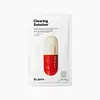What's inside
What's inside
 Key Ingredients
Key Ingredients

 Benefits
Benefits

 Concerns
Concerns

 Ingredients Side-by-side
Ingredients Side-by-side

Glycerin
HumectantNiacinamide
SmoothingGlycereth-26
HumectantSodium Hyaluronate
HumectantCalcium Pantothenate
Sodium Ascorbyl Phosphate
AntioxidantTocopheryl Acetate
AntioxidantPyridoxine Hcl
Skin ConditioningMaltodextrin
AbsorbentSodium Starch Octenylsuccinate
AbsorbentSilica
AbrasiveTrehalose
HumectantHydroxyethyl Urea
HumectantBetaine
HumectantErythritol
HumectantGlutathione
PEG/PPG-17/6 Copolymer
SolventButylene Glycol
HumectantPEG-14m
Emulsion StabilisingAllantoin
Skin ConditioningXanthan Gum
EmulsifyingMelaleuca Alternifolia Leaf Oil
AntioxidantSalicylic Acid
MaskingDisodium EDTA
Carbomer
Emulsion StabilisingTriethanolamine
BufferingPEG-60 Hydrogenated Castor Oil
EmulsifyingEthylhexylglycerin
Skin ConditioningPhenoxyethanol
PreservativeGlycerin, Niacinamide, Glycereth-26, Sodium Hyaluronate, Calcium Pantothenate, Sodium Ascorbyl Phosphate, Tocopheryl Acetate, Pyridoxine Hcl, Maltodextrin, Sodium Starch Octenylsuccinate, Silica, Trehalose, Hydroxyethyl Urea, Betaine, Erythritol, Glutathione, PEG/PPG-17/6 Copolymer, Butylene Glycol, PEG-14m, Allantoin, Xanthan Gum, Melaleuca Alternifolia Leaf Oil, Salicylic Acid, Disodium EDTA, Carbomer, Triethanolamine, PEG-60 Hydrogenated Castor Oil, Ethylhexylglycerin, Phenoxyethanol
Water
Skin ConditioningMethylpropanediol
SolventGlycerin
HumectantEthyl Perfluoroisobutyl Ether
SolventEthyl Perfluorobutyl Ether
SolventSapindus Mukorossi Fruit Extract
Skin ConditioningAcrylates Copolymer
Betaine
HumectantHydroxyacetophenone
AntioxidantPolyacrylamide
C13-14 Isoparaffin
EmollientTromethamine
BufferingDimethicone
EmollientAllantoin
Skin ConditioningLaureth-7
Emulsifying1,2-Hexanediol
Skin ConditioningEthylhexylglycerin
Skin ConditioningAdenosine
Skin ConditioningCitrus Aurantium Dulcis Oil
MaskingButylene Glycol
HumectantLonicera Japonica Flower Extract
Skin ConditioningPolyglyceryl-10 Stearate
Skin ConditioningLonicera Caprifolium Flower Extract
PerfumingDisodium EDTA
Helianthus Annuus Seed Oil
EmollientRhus Semialata Gall Extract
Skin ConditioningGlyceryl Acrylate/Acrylic Acid Copolymer
HumectantAlthaea Rosea Flower Extract
Skin ConditioningHydrogenated Lecithin
EmulsifyingCaffeine
Skin ConditioningAlcohol
AntimicrobialPelargonium Graveolens Flower Oil
MaskingCananga Odorata Flower Oil
MaskingCitrus Aurantium Bergamia Fruit Oil
MaskingPropanediol
SolventLecithin
EmollientPistacia Lentiscus Gum
MaskingRosa Damascena Flower Oil
MaskingMelaleuca Viridiflora Leaf Oil
Skin ConditioningButyl Avocadate
Skin ConditioningIris Ensata Extract
Skin ConditioningMaltodextrin
AbsorbentMoringa Oleifera Seed Extract
Skin ConditioningAsparagus Officinalis Stem Extract
Skin ConditioningEucalyptus Globulus Leaf Extract
PerfumingCalcium Carbonate
AbrasiveGluconolactone
Skin ConditioningPotassium Sorbate
PreservativeSodium Benzoate
MaskingPropyl Gallate
AntioxidantWater, Methylpropanediol, Glycerin, Ethyl Perfluoroisobutyl Ether, Ethyl Perfluorobutyl Ether, Sapindus Mukorossi Fruit Extract, Acrylates Copolymer, Betaine, Hydroxyacetophenone, Polyacrylamide, C13-14 Isoparaffin, Tromethamine, Dimethicone, Allantoin, Laureth-7, 1,2-Hexanediol, Ethylhexylglycerin, Adenosine, Citrus Aurantium Dulcis Oil, Butylene Glycol, Lonicera Japonica Flower Extract, Polyglyceryl-10 Stearate, Lonicera Caprifolium Flower Extract, Disodium EDTA, Helianthus Annuus Seed Oil, Rhus Semialata Gall Extract, Glyceryl Acrylate/Acrylic Acid Copolymer, Althaea Rosea Flower Extract, Hydrogenated Lecithin, Caffeine, Alcohol, Pelargonium Graveolens Flower Oil, Cananga Odorata Flower Oil, Citrus Aurantium Bergamia Fruit Oil, Propanediol, Lecithin, Pistacia Lentiscus Gum, Rosa Damascena Flower Oil, Melaleuca Viridiflora Leaf Oil, Butyl Avocadate, Iris Ensata Extract, Maltodextrin, Moringa Oleifera Seed Extract, Asparagus Officinalis Stem Extract, Eucalyptus Globulus Leaf Extract, Calcium Carbonate, Gluconolactone, Potassium Sorbate, Sodium Benzoate, Propyl Gallate
 Reviews
Reviews

Ingredients Explained
These ingredients are found in both products.
Ingredients higher up in an ingredient list are typically present in a larger amount.
Allantoin is a soothing ingredient known for its protective and moisturizingg properties. Because of this, it is often added to products with strong active ingredients.
Studies show higher concentrations of this ingredient can promote wound healing.
Though it can be derived from the comfrey plant, allantoin is produced synthetically for cosmetic products to ensure purity.
Learn more about AllantoinBetaine is a common humectant (a substance that promotes retention of moisture). It's known to be gentle on the skin and can help balance hydration.
This ingredient is best for improving hydration and soothing irritated skin. Studies also show it helps even out skin tone.
Fun fact: Betaine is naturally created in the skin and body. The kind found within cosmetic products can be either plant-derived or synthetic.
Another name for betaine is trimethylglycine.
Learn more about BetaineButylene Glycol (or BG) is used within cosmetic products for a few different reasons:
Overall, Butylene Glycol is a safe and well-rounded ingredient that works well with other ingredients.
Though this ingredient works well with most skin types, some people with sensitive skin may experience a reaction such as allergic rashes, closed comedones, or itchiness.
Learn more about Butylene GlycolDisodium EDTA plays a role in making products more stable by aiding other preservatives.
It is a chelating agent, meaning it neutralizes metal ions that may be found in a product.
Disodium EDTA is a salt of edetic acid and is found to be safe in cosmetic ingredients.
Learn more about Disodium EDTAEthylhexylglycerin (we can't pronounce this either) is commonly used as a preservative and skin softener. It is derived from glyceryl.
You might see Ethylhexylglycerin often paired with other preservatives such as phenoxyethanol. Ethylhexylglycerin has been found to increase the effectiveness of these other preservatives.
Glycerin is already naturally found in your skin. It helps moisturize and protect your skin.
A study from 2016 found glycerin to be more effective as a humectant than AHAs and hyaluronic acid.
As a humectant, it helps the skin stay hydrated by pulling moisture to your skin. The low molecular weight of glycerin allows it to pull moisture into the deeper layers of your skin.
Hydrated skin improves your skin barrier; Your skin barrier helps protect against irritants and bacteria.
Glycerin has also been found to have antimicrobial and antiviral properties. Due to these properties, glycerin is often used in wound and burn treatments.
In cosmetics, glycerin is usually derived from plants such as soybean or palm. However, it can also be sourced from animals, such as tallow or animal fat.
This ingredient is organic, colorless, odorless, and non-toxic.
Glycerin is the name for this ingredient in American English. British English uses Glycerol/Glycerine.
Learn more about GlycerinMaltodextrin is a polysaccharide. It is derived from starch such as rice, corn, wheat, or potato starch.
In food, Maltodextrin is used to improve the texture and thicken a product. Due to its structure, it can help create a gel texture. As an emulsion stabilizer, it helps keep the ingredients in a product together.
As a polysaccharide, Maltodextrin has moisturizing properties. Polysaccharides are a type of carbohydrate. The top layer of skin uses polysaccharides to retain water, keeping the skin hydrated.
Maltodextrin is water soluble and has a sweet taste.
Learn more about Maltodextrin